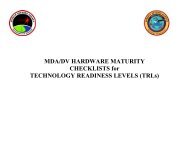bmdo technologies for biomedical applications - MDA Technology
bmdo technologies for biomedical applications - MDA Technology
bmdo technologies for biomedical applications - MDA Technology
Create successful ePaper yourself
Turn your PDF publications into a flip-book with our unique Google optimized e-Paper software.
40LiSAF LASER FORCYTOMETERS• Compact laser technology can helpimprove flow cytometry.BMDO HISTORYA new diode-pumped solid-state lithium strontium aluminum fluoride(LiSAF) laser is being developed by Science and Engineering Services,Inc. (SESI; Burtonsville, MD). It will provide simultaneous output wavelengthsof 490 and 980 nanometers. The Q-switched laser is based on aLiSAF crystal, doped with chromium. The short laser pulse durationsand solid-state nature of the laser contributeto the system’s low power consumption,compactness, and reliabilityCell sorters or cytometersunder severe vibrational stress and widehave become very sophisticatedin a short time in ed Phase II funding <strong>for</strong> this ef<strong>for</strong>t, withtemperature variation. BMDO has provid-matching funds provided by the Army andpart because of the Recon Exploration (Dallas, TX). BMDOhas also funded the development of frequency-agilelasers <strong>for</strong> spaceborne spec-enormous demand thattroscopic plat<strong>for</strong>ms, LIDAR, tracking,creative biologists havedetection of atmospheric constituents, anddetection of wind shear. SESI has per<strong>for</strong>medresearch with NASA, the Army, thebrought to bear on theindustry. Advances in Navy, and the National Science Foundationin the areas of atmospheric sensing, LIDAR,lasers, coupled with general laser development, and novel medicalinstrumentation.newly available dyes andHOW IT WORKSever-increasing antigenantibodycombinations, a high repetition rate (1 to 2 kilohertz) andThe laser is tunable within a fundamentalrange of 780 to 1,000 nanometers and hasmicrojoule pulse capability (50 to 80 microjoules).SESI plans to couple the LiSAF laserhave played a large part insystem to a flow cytometer to make it morewidening the range of cellreliable than cytometers operated with nonsolid-state,continuous-wave laser outputs.types that can be identifiedA flow cytometer is a device that uses a laserwith cytometers.to detect the fluorescence intensity of cellsthat flow past a detector in a thin stream. Iffluorescence is detected, the cell is given anelectrical charge and deflected into a collection bin. The simultaneous outputof two different wavelengths can expand a cytometer’s ability to sortmultiple cell types during one sorting run. By frequency doubling, the secondharmonic of the laser can provide blue-green activity, tunable from390 to 500 nanometers, that would be valuable in the communicationsChapter 2 - Observation TechnologiesSection B - AnalysisBMDO Technologies <strong>for</strong> Biomedical Applications




